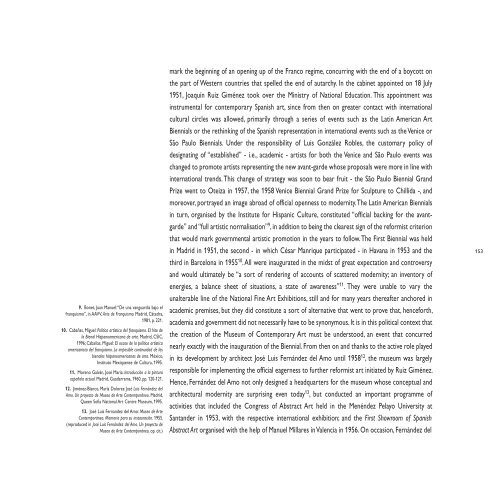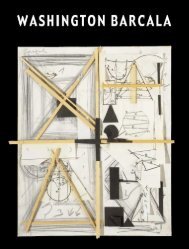VERSIÓN INGLESA ENGLISH VERSION - Fundación César Manrique
VERSIÓN INGLESA ENGLISH VERSION - Fundación César Manrique
VERSIÓN INGLESA ENGLISH VERSION - Fundación César Manrique
Create successful ePaper yourself
Turn your PDF publications into a flip-book with our unique Google optimized e-Paper software.
9. Bonet, Juan Manuel: “De una vanguardia bajo el<br />
franquismo”, in AAVV, Arte de Franquismo. Madrid, Cátedra,<br />
1981, p. 221.<br />
10. Cabañas, Miguel: Política artística del franquismo. El hito de<br />
la Bienal Hispanoamericana de arte. Madrid, CSIC,<br />
1996; Cabañas, Miguel: El ocaso de la política artística<br />
americanista del franquismo. La imposible continuidad de las<br />
bienales hispanoamericanas de arte. México,<br />
Instituto Mexiquense de Cultura, 1995.<br />
11. Moreno Galván, José María: Introducción a la pintura<br />
española actual. Madrid, Guadarrama, 1960, pp. 120-121.<br />
12. Jiménez-Blanco, María Dolores: José Luis Fernández del<br />
Amo. Un proyecto de Museo de Arte Contemporáneo. Madrid,<br />
Queen Sofía National Art Centre Museum, 1995.<br />
13. José Luis Fernandez del Amo: Museo de Arte<br />
Contemporáneo. Memoria para su instauración. 1955.<br />
(reproduced in José Luis Fernández del Amo. Un proyecto de<br />
Museo de Arte Contemporáneo, op. cit.)<br />
mark the beginning of an opening up of the Franco regime, concurring with the end of a boycott on<br />
the part of Western countries that spelled the end of autarchy. In the cabinet appointed on 18 July<br />
1951, Joaquín Ruiz Giménez took over the Ministry of National Education. This appointment was<br />
instrumental for contemporary Spanish art, since from then on greater contact with international<br />
cultural circles was allowed, primarily through a series of events such as the Latin American Art<br />
Biennials or the rethinking of the Spanish representation in international events such as the Venice or<br />
São Paulo Biennials. Under the responsibility of Luis González Robles, the customary policy of<br />
designating of “established” - i.e., academic - artists for both the Venice and São Paulo events was<br />
changed to promote artists representing the new avant-garde whose proposals were more in line with<br />
international trends. This change of strategy was soon to bear fruit - the São Paulo Biennial Grand<br />
Prize went to Oteiza in 1957, the 1958 Venice Biennial Grand Prize for Sculpture to Chillida -, and<br />
moreover, portrayed an image abroad of official openness to modernity. The Latin American Biennials<br />
in turn, organised by the Institute for Hispanic Culture, constituted “official backing for the avantgarde”<br />
and “full artistic normalisation” 9 , in addition to being the clearest sign of the reformist criterion<br />
that would mark governmental artistic promotion in the years to follow. The First Biennial was held<br />
in Madrid in 1951, the second - in which <strong>César</strong> <strong>Manrique</strong> participated - in Havana in 1953 and the<br />
third in Barcelona in 1955 10 . All were inaugurated in the midst of great expectation and controversy<br />
and would ultimately be “a sort of rendering of accounts of scattered modernity; an inventory of<br />
energies, a balance sheet of situations, a state of awareness” 11 . They were unable to vary the<br />
unalterable line of the National Fine Art Exhibitions, still and for many years thereafter anchored in<br />
academic premises, but they did constitute a sort of alternative that went to prove that, henceforth,<br />
academia and government did not necessarily have to be synonymous. It is in this political context that<br />
the creation of the Museum of Contemporary Art must be understood, an event that concurred<br />
nearly exactly with the inauguration of the Biennial. From then on and thanks to the active role played<br />
in its development by architect José Luis Fernández del Amo until 1958 12 , the museum was largely<br />
responsible for implementing the official eagerness to further reformist art initiated by Ruiz Giménez.<br />
Hence, Fernández del Amo not only designed a headquarters for the museum whose conceptual and<br />
architectural modernity are surprising even today 13 , but conducted an important programme of<br />
activities that included the Congress of Abstract Art held in the Menéndez Pelayo University at<br />
Santander in 1953, with the respective international exhibition; and the First Showroom of Spanish<br />
Abstract Art organised with the help of Manuel Millares in Valencia in 1956. On occasion, Fernández del<br />
153
















![Becas y premios de la Fundación César Manrique [1997-2006]](https://img.yumpu.com/20766851/1/184x260/becas-y-premios-de-la-fundacion-cesar-manrique-1997-2006.jpg?quality=85)
